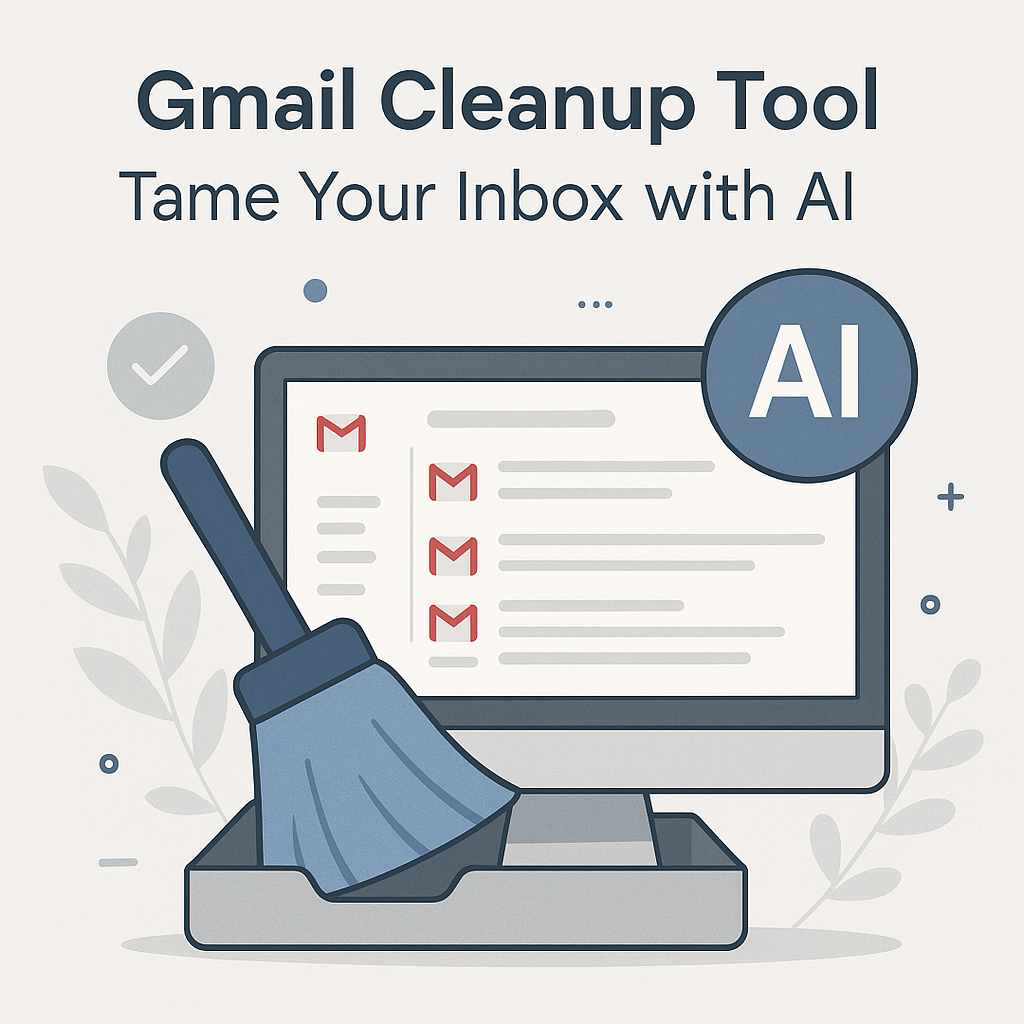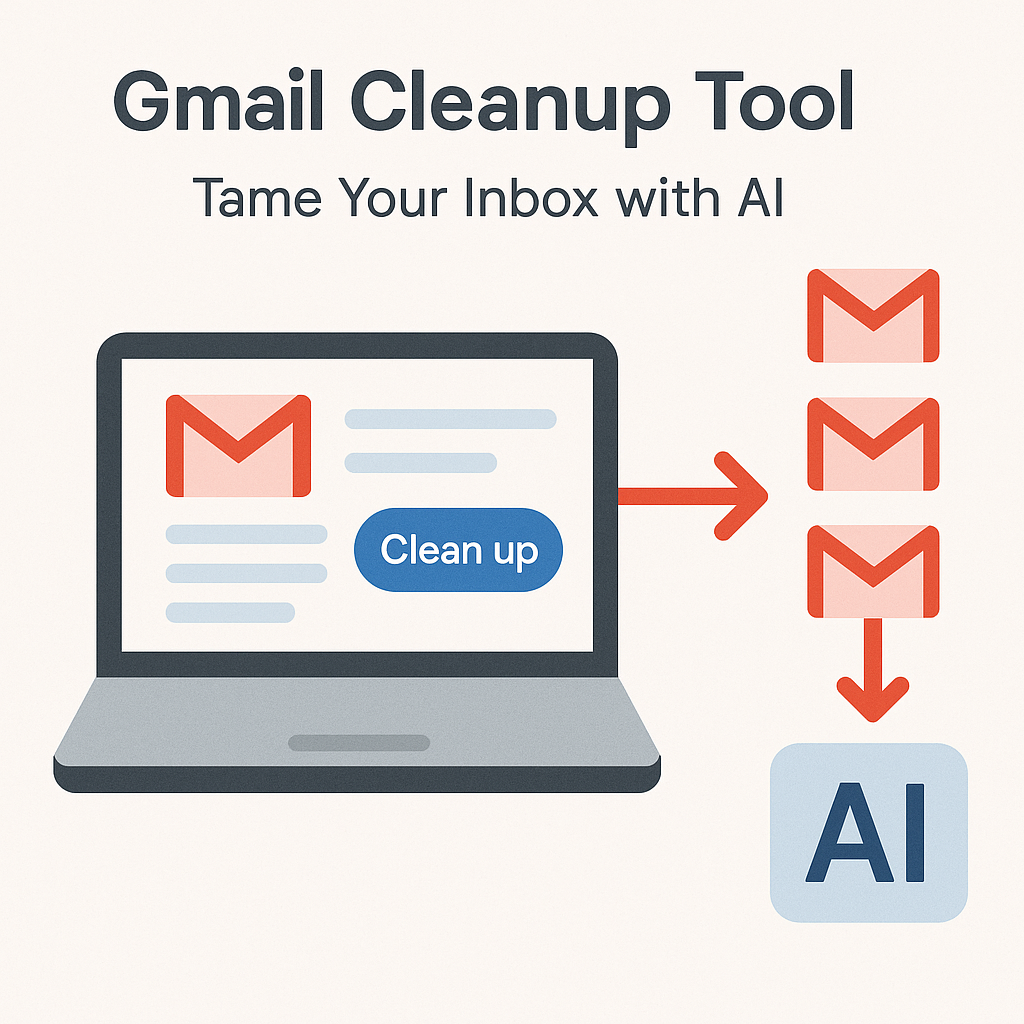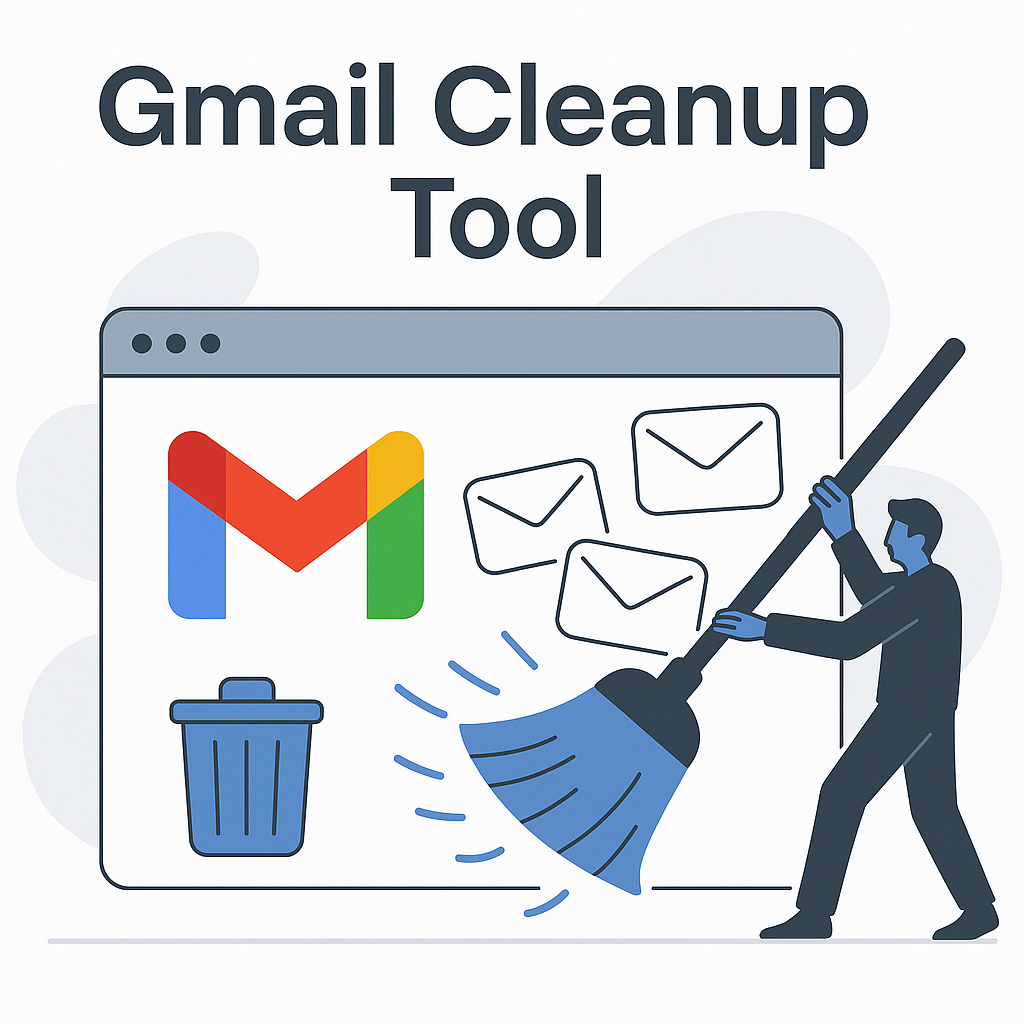Gmail Cleanup Tool: Tame Your Inbox with AI

In today's fast-paced professional world, your inbox can quickly transform from a communication hub into a relentless source of stress and distraction. Imagine trying to find that critical client proposal buried under hundreds of newsletters, automated notifications, and promotional offers. It's a common scenario for busy executives, entrepreneurs, and sales professionals. This constant battle with email overload leads to missed deadlines, lost opportunities, and a significant drain on productivity. The sheer volume of incoming messages can feel insurmountable, making it challenging to focus on what truly matters. But what if there was a smarter, more efficient way to manage this digital deluge? Enter the powerful capabilities of a gmail cleanup tool.
The Pain of a Cluttered Gmail Inbox
We've all been there. You open your Gmail, and the number next to the inbox label is a daunting figure. It's not just about the number; it's about the mental energy required to even approach it. A cluttered inbox isn't just an aesthetic problem; it's a productivity killer.- Missed Important Emails: Critical messages from clients, colleagues, or partners can easily get lost amidst the noise. This can lead to delayed responses, damaged relationships, and missed business opportunities.
- Wasted Time Searching: How much time do you spend each week sifting through old emails, trying to find a specific piece of information? Studies suggest professionals spend a significant portion of their day just managing email, a large chunk of which is spent searching.
- Decreased Productivity and Focus: Constant email notifications and the overwhelming task of sorting through them create context-switching, which is detrimental to deep work. This leads to fragmented attention spans and a general feeling of being overwhelmed.
- Increased Stress and Burnout: An unmanageable inbox contributes to feelings of anxiety and being constantly behind. It's a persistent reminder of unfinished tasks, leading to mental fatigue and potential burnout.
- Reduced Email Effectiveness: When your inbox is a mess, your ability to respond promptly and professionally suffers. This can impact your professional image and the efficiency of your communication.
What is a Gmail Cleanup Tool and How Does it Work?
At its core, a gmail cleanup tool is a software application or service designed to automate and simplify the process of managing your email inbox. Instead of manually sifting through every message, these tools employ sophisticated algorithms and user-defined rules to sort, categorize, archive, and delete emails based on specific criteria. Think of it as a digital assistant for your inbox. These tools connect securely to your Gmail account and perform a range of actions, including:- Bulk Deletion and Archiving: Quickly remove or archive thousands of emails at once, often based on sender, keywords, or date ranges.
- Unsubscribe Automation: Easily identify and unsubscribe from unwanted newsletters and mailing lists that contribute to inbox clutter.
- Intelligent Sorting and Labeling: Automatically categorize emails into predefined folders or apply labels based on content or sender, making retrieval easier.
- Spam and Junk Filtering: Enhance Gmail's native filtering to catch more unwanted messages before they hit your main inbox.
- Identifying Large Attachments: Help clear up storage space and declutter by flagging emails with large attachments.
The Role of AI in Smart Triage and Prioritization
While traditional cleanup tools offer significant benefits, the real game-changer in modern email management is Artificial Intelligence (AI). AI-powered email solutions take email organization to an entirely new level by enabling "smart triage" and intelligent prioritization. Traditional email filtering relies on static rules you set up manually. AI, however, learns and adapts. It can analyze the content, sender patterns, and even the language used in your emails to understand what is important, urgent, or merely informational. This capability is crucial for anyone looking to effectively manage email overload. Here's how AI makes a difference in smart triage and prioritization:- Understanding Context and Urgency: AI algorithms can detect keywords, sentiment, and sender reputation to gauge the importance of an email. For instance, an email from your CEO with an urgent request might be flagged differently than a weekly company newsletter, even if both contain the word "urgent."
- Predictive Sorting: Based on your past interactions, AI can predict which emails you're most likely to want to see first. It learns which senders you respond to quickly, which subjects require immediate attention, and which types of emails you tend to archive without reading.
- Summarization and Key Information Extraction: Some advanced AI tools can even summarize lengthy email threads or extract key action items, allowing you to grasp the essence of a message without reading every word. This is invaluable for busy professionals who need to digest information rapidly.
- Automated Action Recommendations: AI can suggest actions like archiving, deleting, or flagging emails based on learned user behavior, further automating the cleanup process.
Key Features of Effective Gmail Cleanup Tools
When selecting a gmail cleanup tool, certain features stand out for their ability to deliver maximum impact on your productivity and email organization. A truly effective tool goes beyond basic deletion and offers intelligent automation.Intelligent Filtering and Categorization
* **Smart Sorting:** Beyond Gmail's default categories (Primary, Social, Promotions), AI-powered tools can create custom categories based on sender, keywords, or even project relevance. This ensures that emails related to specific clients or ongoing projects are grouped together. * **Priority Inbox Simulation:** Many tools can mimic or enhance Gmail's Priority Inbox feature, learning which emails you deem most important and surfacing them accordingly.Bulk Actions for Efficiency
* **Mass Unsubscribe:** A common pain point is the endless stream of unwanted subscriptions. Tools that can scan your inbox and allow you to unsubscribe from multiple lists with a single click are incredibly valuable. As Inbox Zapper notes, "You can effortlessly unsubscribe from email lists and newsletters, or mass delete emails with just one click." (Inbox Zapper). * **Batch Archiving/Deletion:** The ability to select all emails from a specific sender, or all emails older than a certain date, and perform a bulk action (archive, delete, or move to a folder) can clear out thousands of messages in minutes.Custom Rule Creation
* **User-Defined Automation:** While AI handles much of the heavy lifting, the ability to create your own specific rules offers granular control. For example, you might set a rule to automatically archive all emails from a specific automated system after 30 days, or to label all emails containing "invoice" for accounting. * **Rule Templates:** Some tools offer pre-built templates for common cleanup tasks, making it easier to get started.Security and Privacy
* **OAuth 2.0 Authentication:** Ensure the tool uses secure methods to access your Gmail account, typically OAuth 2.0, which doesn't require sharing your password. * **Data Handling Policies:** Understand how the tool handles your data. Reputable tools will have clear privacy policies outlining their practices.Integration and User Experience
* **Seamless Gmail Integration:** The best tools feel like a natural extension of Gmail, not a separate, clunky interface. * **Intuitive Interface:** A clean, easy-to-navigate dashboard makes configuring and managing your cleanup rules straightforward. * **Mobile Accessibility:** For professionals on the go, having a mobile-friendly interface or app is a significant advantage. By focusing on these key features, you can select a gmail cleanup tool that not only helps you declutter Gmail but also enhances your overall email productivity tools strategy.How a Gmail Cleanup Tool Boosts Productivity for Professionals
For executives, entrepreneurs, and sales professionals, time is arguably their most valuable asset. A chaotic inbox directly erodes this asset, leading to a cascade of negative impacts. Implementing a robust gmail cleanup tool is not just about tidiness; it's a strategic move to reclaim time, reduce stress, and significantly boost productivity.Reclaiming Time for Strategic Tasks
The most immediate benefit is the sheer amount of time saved. Instead of spending 30-60 minutes daily manually sorting, deleting, or searching, a cleanup tool can automate these processes. This reclaimed time can be reinvested in:- Client Engagement: More time for personalized outreach, follow-ups, and building stronger client relationships. This directly impacts your email conversion rate.
- Strategic Planning: Focus on high-level tasks, business development, and long-term goals rather than getting bogged down in administrative email management.
- Sales Activities: Dedicate more hours to prospecting, demoing, and closing deals, rather than sorting through irrelevant messages.
Reducing Stress and Mental Clutter
An overflowing inbox is a constant psychological burden. It signals unfinished work and a lack of control. By automating the cleanup, a tool helps to:- Lower Anxiety Levels: Seeing a manageable inbox reduces the feeling of being overwhelmed and makes approaching email less daunting.
- Improve Mental Focus: Less time spent on email management means more mental energy available for complex problem-solving and creative thinking.
- Prevent Burnout: By creating a more sustainable workflow, these tools contribute to a healthier work-life balance and reduce the risk of burnout.
Enhancing Focus and Prioritization
With a cleaner inbox, it becomes significantly easier to identify and act on what's most important. This means:- Faster Identification of Critical Emails: When important messages aren't buried, you can respond more quickly, improving your click rate email response times on important communications.
- Streamlined Workflow: Knowing that your inbox is organized allows you to approach it with a clear strategy, rather than feeling like you're constantly playing catch-up.
- Effective Delegation: For managers and executives, tools can help sort emails that can be delegated. This is akin to leveraging virtual assistant tasks to manage your communication flow more efficiently.
Step-by-Step Guide to Cleaning Your Gmail Inbox with a Tool
Ready to take control of your inbox? Here’s a general step-by-step process for using a gmail cleanup tool to achieve better email organization and manage email overload. While specific interfaces vary, the core principles remain consistent.Step 1: Choose Your Gmail Cleanup Tool
Before you begin, select a tool that best fits your needs. Consider features, pricing, security, and user reviews. For example, some tools focus heavily on unsubscribing, while others offer advanced AI-powered sorting. You can find options on platforms like the Google Workspace Marketplace.Step 2: Securely Connect Your Gmail Account
Most tools will require you to grant them access to your Gmail account. This is typically done via OAuth 2.0, a secure authorization protocol that allows the tool to access your emails without needing your password. Always ensure the tool you choose uses this method and has a clear privacy policy.Step 3: Perform an Initial Scan and Review
Once connected, the tool will likely scan your inbox to identify patterns, such as frequent senders, large emails, or common promotional categories. Take a moment to review the initial findings. The tool might present you with common categories of emails that are candidates for cleanup.Step 4: Configure Rules and Filters
This is where you start tailoring the automation. * **Set up Unsubscribe Rules:** Identify newsletters or marketing emails you no longer wish to receive and use the tool's features to unsubscribe in bulk. * **Define Archiving/Deletion Rules:** Specify criteria for automatic archiving or deletion. Examples: * Archive all emails from '[email protected]' older than 60 days. * Delete all emails with "Order Confirmation" in the subject from the last year. * Label and archive all notifications from social media platforms. * **Prioritize Important Senders:** Ensure emails from key contacts (boss, important clients) are never automatically archived or deleted, and perhaps are even flagged for immediate attention.Step 5: Utilize Bulk Actions
After setting up rules, you'll likely have the option to perform immediate bulk actions. This is your chance to clear out years of accumulated clutter. For instance, you might: * Select all emails from specific promotional senders and archive them. * Delete all emails older than 5 years that don't contain important keywords. * Archive all emails with large attachments that you've already downloaded.Step 6: Set Up Ongoing Automation
Once your initial cleanup is done, configure the tool to run automatically on a daily or weekly basis. This ensures your inbox remains manageable moving forward. Many tools will run these processes in the background, so you don't have to actively manage them.Step 7: Regularly Review and Adjust
No automation is perfect from the start. Periodically review the actions taken by the tool. Did it archive something important? Did it miss a category of emails you want cleaned? Adjust your rules and settings as needed. This iterative process is key to maintaining an efficient inbox and achieving long-term inbox zero. By following these steps, you can systematically declutter your Gmail and establish a sustainable system for managing your email efficiently.Choosing the Right Gmail Cleanup Tool for Your Needs
With a growing number of email productivity tools available, selecting the right gmail cleanup tool can feel overwhelming. However, by considering a few key factors, you can find a solution that perfectly aligns with your workflow and goals for effective email organization.1. Your Primary Goal: What Do You Need Most?
* **Massive Decluttering:** If your inbox is a disaster zone with tens of thousands of unread emails, look for tools with powerful bulk actions and advanced filtering for initial cleanup. * **Ongoing Management:** For maintaining a tidy inbox day-to-day, focus on tools with intelligent automation, smart categorization, and simple rule creation. * **Unsubscribe Automation:** If promotional emails are your biggest headache, prioritize tools that excel at mass unsubscribing and blocking unwanted senders. * **Advanced Prioritization:** If you need help identifying truly urgent emails amidst the noise, AI-driven sorting and prioritization features are essential.2. Features and Functionality
As discussed earlier, key features to look for include: * Intelligent filtering based on AI or advanced rules. * Bulk actions (delete, archive, label). * Unsubscribe capabilities. * Custom rule creation. * Reporting or insights into your inbox habits. Some tools, like those highlighted by Bardeen.ai, offer comprehensive suites of AI-powered email management features, including summarization and drafting capabilities. (Bardeen.ai).3. Security and Privacy Policies
This cannot be stressed enough. Your email contains sensitive information. Ensure the tool uses secure connection methods (like OAuth 2.0) and has a transparent privacy policy that clearly states how your data is used, stored, and protected. Avoid tools that ask for unnecessary permissions or seem vague about their data practices.4. Ease of Use and User Interface
A tool that is overly complex will likely become another chore. Look for an intuitive interface that makes it easy to set up rules, perform actions, and understand what the tool is doing. A good user experience is crucial for sustained adoption.5. Pricing and Value
Many cleanup tools offer free trials or freemium versions. Evaluate whether a paid subscription offers sufficient value for the time and stress savings it provides. Consider your budget and compare pricing models (one-time fee vs. subscription).6. Integration Capabilities
Does the tool integrate smoothly with Gmail? Some tools might offer browser extensions, while others are standalone web applications. For executives seeking advanced email management and delegation capabilities, consider solutions like an ai executive assistant. These platforms often integrate sophisticated AI to handle complex email sorting, response drafting, and task management, going beyond simple cleanup to truly optimize your communication workflow. Such comprehensive solutions can be particularly beneficial for professionals who need robust email task management and streamlined communication. By carefully evaluating these points, you can select a gmail cleanup tool that not only helps you declutter Gmail but also enhances your overall efficiency and supports your journey towards inbox zero.Conclusion: Reclaim Your Inbox and Your Time
The battle against email overload is a constant challenge in the modern professional landscape. A cluttered Gmail inbox can lead to missed opportunities, wasted time, increased stress, and diminished productivity. However, by embracing the power of a gmail cleanup tool, you can systematically tackle this problem and transform your email experience. From automating the deletion of unwanted messages to intelligently prioritizing critical communications using AI, these tools offer a sophisticated approach to email organization. They empower busy professionals, including executives, entrepreneurs, and sales teams, to reclaim valuable hours, reduce mental fatigue, and focus on what truly drives their success. By leveraging smart triage, bulk actions, and custom rules, you can move from a state of inbox chaos to one of streamlined efficiency. Investing time in choosing and configuring the right gmail cleanup tool is an investment in your own productivity and well-being. Don't let your inbox dictate your day. Take control, declutter your digital workspace, and rediscover the time and focus you need to excel. Start your journey to a cleaner, more productive inbox today, and experience the freedom that comes with mastering your communication flow.


